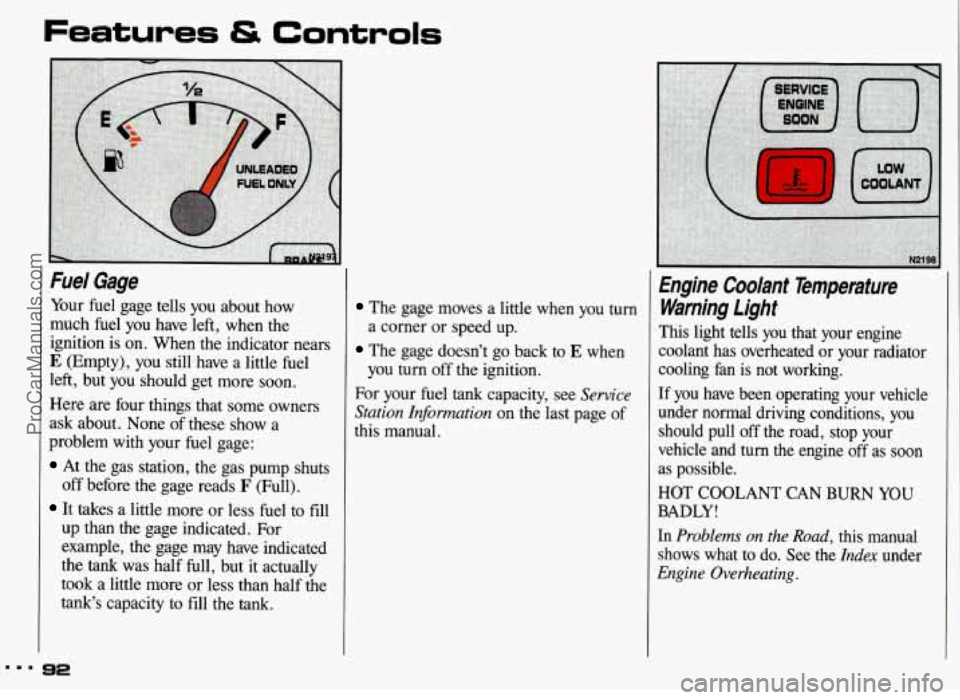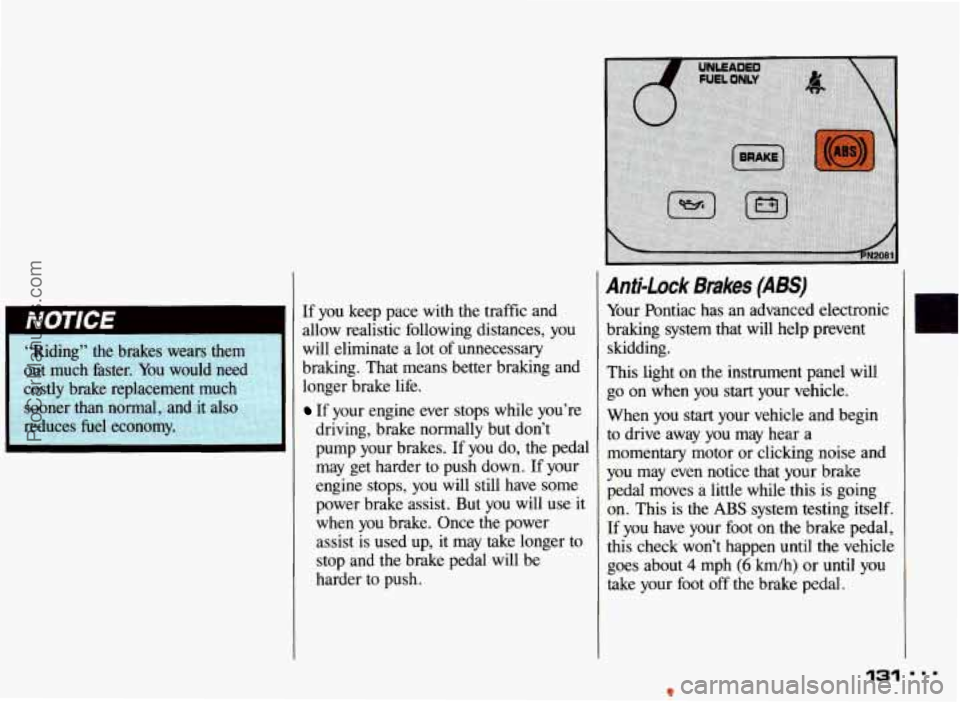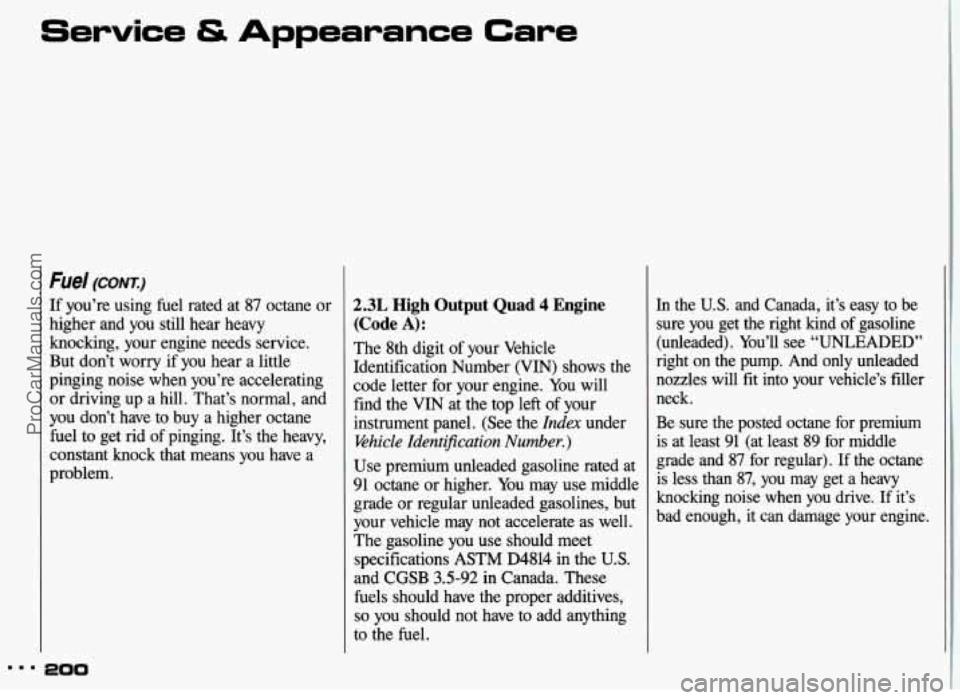Page 93 of 306

Fuel Gage
Your fuel gage tells you about how
much fuel you have left, when the
ignition is on. When the indicator nears
E (Empty), you still have a little fuel
left, but you should get more soon.
Here are four things that some owners
ask about. None
of these show a
problem with
your fuel gage:
At the gas station, the gas pump shuts
off before the gage reads
F (Full).
It takes a little more or less fuel to fill
up than the gage indicated. For
example, the gage may have indicated
the
tank was half full, but it actually
took a little more or less than half the
tank’s capacity to fill the tank.
The gage moves a little when you turn
The gage doesn’t go back to E when
For your fuel tank capacity, see
Service
Station Information
on the last page of
this manual. a
corner or speed up.
you turn off the ignition.
Engine Coolant Temperature
Warning Light
This light tells you that your engine
coolant has overheated or your radiator
cooling fan is not working.
If you have been operating your vehicle
under normal driving conditions, you
should pull off the road, stop your
vehicle and turn the engine
off as soon
as possible.
HOT
COOLANT CAN BURN YOU
BADLY!
In Problems on the Road, this manual
shows what to do. See the
Index under
Engine Overheating.
ProCarManuals.com
Page 132 of 306

“Riding” the brakes wears them
out much faster. You would need
costly brake replacement
much
sooner than normal, and it also reduces fuel economy. If you keep pace with the traffic and
allow realistic following distances,
you
will eliminate a lot of unnecessary
braking. That means better braking and
longer brake life. If your engine ever stops while you’re
driving, brake normally but don’t
pump your brakes. If you do, the pedal
may get harder to push down. If your
engine stops, you will still have some
power brake assist. But
you will use it
when you brake. Once the power
assist is used up, it may take longer
to
stop and the brake pedal will be
harder to push.
Anti-Lock Bmkes (ABS)
Your Pontiac has an advanced electronic
braking system that will help prevent
skidding.
This light on the instrument panel will
go on when you start your vehicle.
When you
start your vehicle and begin
to drive away you may hear a
momentary motor or clicking noise
and
you may even notice that your brake
pedal moves a little while this is going
on. This is the ABS system testing itself.
If you have your foot on the brake
pedal,
this check won’t happen until the vehicle
goes about
4 mph (6 km/h) or until you
take your foot off the brake pedal.
131
ProCarManuals.com
Page 200 of 306
Fuel
2.3L Quad OHC and Quad 4 Engines
(Codes
3 and D) and 3300 V6 Engine
(Code
N):
The 8th digit of your Vehicle
Identification Number (VIN) shows the
code letter for your engine. You will
find the VIN at the top left
of your
instrument panel. (See the
Idex under
&hicle Identijkation Number.)
Use regular unleaded gasoline rated at
87 octane or higher. It should meet
specifications ASTM D4814
in the U.S.
and CGSB 3.5-92 in Canada. These
fuels should have the proper additives,
so you should not have to add anything
to the fuel. In the
U.S. and
Canada, it’s easy to be
sure you get the right kind
of gasoline
(unleaded). You’ll see “UNLEADED”
right on the pump. And only unleaded
nozzles will fit into your vehicle’s filler neck.
Be sure the posted octane is at least
87.
If the octane is less than 87, you may get
a heavy knocking noise when you drive.
If it’s bad enough, it can damage your
engine.
19s
ProCarManuals.com
Page 201 of 306

Service & Appearance Care
Fuel (CONT.:)
If you’re using fuel rated at 87 octane or
higher and you still hear heavy
knocking, your engine needs service.
But don’t
worry if you hear a little
pinging noise when you’re accelerating or driving up a hill. That’s normal, and
you don’t have to buy a higher octane
fuel to get rid of pinging. It’s the heavy,
constant knock that means you have a
txoblem.
2.3L High Output Quad 4 Engine
(Code
A):
The 8th digit of your Vehicle
Identification Number
(VIN) shows the
code letter for your engine. You will
find the VIN at the top left of your
instrument panel. (See the
Index under
Rhicle ldentijication Number.)
Use premium unleaded gasoline rated at
91 octane or higher. You may use middle
grade or regular unleaded gasolines, but
your vehicle may not accelerate as well.
The gasoline
you use should meet
specifications
ASTM D4814 in the U.S.
and CGSB 3.5-92 in Canada. These
fuels should have the proper additives,
so you should not have to add anything
to the fuel.
In the U.S. and Canada, it’s easy to be
sure
you get the right kind of gasoline
(unleaded).
You’ll see “UNLEADED”
right on the pump. And only unleaded
nozzles will
fit into your vehicle’s filler
neck.
Be sure the posted octane for premium
is at least 91 (at least 89 for middle
grade and
87 for regular). If the octane
is less than
87, you may get a heavy
knocking noise when you drive.
If it’s
bad enough, it can damage your engine.
888 a00
ProCarManuals.com
Page 250 of 306

Fuse Rating Circuitry
Fuse Usage
HORN
ALARM
HTR-A/C
RDO IGN
TURN
DR LK
TAIL LPS
WDO
WIPER ERLS
FTP
ACC
IGN ECM
HDLP
15
15
25
10
20
20
20
30
25
15
20
30
20
20
Back Up Lights, Electronic PRNDL (automatic transaxle)
Fuel Pump, Fuel Injectors
Turn/Hazard/Stop Lights, Anti-Lock Brakes
(ABS), Brake-
Transaxle Shift Interlock
(BTSI)
Power Door Locks, Power Mirrors, Cigar Lighter
BLANK
Instrument Panel Lights
Rear Window Defogger Relay, Chime, Gages,
ABS , BTSI,
Daytime
Running Lights (Dm) (Canada)
Horn
Chime, Interior Lights, Passive Restraints, Radio/Clock Memory
Heater, Air Conditioning, ABS, DRL (Canada), Engine Block
Heater
Radio, Cruise Control, Variable
Effort Steering
Turn Signals
Power Door Locks
Exterior Lights, Fog Lights, Instrument Panel Lights, DRL
(Canada)
Power Windows (Circuit Breaker)
Windshield WipedWasher
Engine Controls, Starter and Charging System
BLANK
Flash-to-Pass
(US.)
Power Seats, Rear Window Defogger (Circuit Breaker)
BLANK
Engine Control Module, Ignition System
BLANK
Headlights, DRL (Canada) (Circuit Breaker)
ProCarManuals.com
Page 253 of 306
Service & Appearance Care
Capacities & Specifications (CONT.:)
Refrigerant, Air Conditioning. .......................... See refrigerant charge label under hood.
Not all air conditioning refrigerants are the same. If the air
conditioning system in
your vehicle needs refngerant, be sure
the proper refrigerant is used.
If you’re not sure, ask your
Pontiac dealer.
Fuel Tank ......................................... 15.2 gallons 57.5 L
Power Steering
Pump Only ......................................... 1 .OO pint 0.50 L
Complete System .................................... 2.25 pints 1.25 L
Tire Pressures, Sizes. .................................. See Tire-Loading Information label on driver’s
Wheel Nut Torque .................................... 100 pound-feet (140 Nom)
door.
NOTE: All capacities are approximate. When adding, be sure to fill to the appropriate l\
evel or as recommended in
this manual.
... 252
ProCarManuals.com